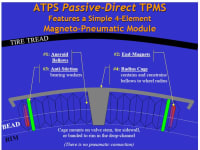

I propose a new approach to implementing vehicular Tire Pressure Monitoring Systems (TPMS) which is more economical and ecological than existing systems mass-deployed in the market to date, with significant advantages, the foremost being the passive non-electronic sending unit (inside the tire) thereby eliminating RF electronics, thermal compensation issues, raising of the RF noise-floor and wasteful consumption of limited Lithium resources for batteries. This is patented, proven field tested technology.
The ATPS TPMS is comprised of two fundamental components per wheel/tire assembly: an in-tire transducer and an external statically mounted chassis sensing component. Signal processing is performed by direct 2 or 3-wire sensor interfaces.
ATPS Pressure Transducer (Sending Unit)
The ATPS pressure transducer directly converts air pressure to a known distance between two permanent magnets, relative to a standard barometric reference (25ºC at sea level). This is accomplished by affixing a permanent magnet on both ends of a cylindrical aneroid bellows. The aneroid bellows is hermetically sealed with an internal atmosphere of nitrogen, which exhibits the same temperature coefficient of expansion as air, without the corrosive ozone or moisture components. The ATPS pressure transducer is extremely reliable and robust, and has a longer lifespan than the vehicle itself. Ejection seats still utilize metallic aneroid bellows to positively determine altitude with extreme, life-sustaining reliability. In addition all THERMAL EFFECTS CANCEL.
ATPS Chassis Component
The active sensing of the magnetic moments or, sending unit’s relative magnetic distance, is accomplished with a magnetic sensor per wheel configured as a digital switch, enabling the transmission of vehicle tire air pressure information wirelessly, and without the use of RF or active circuitry. Each wheel sensor is mounted statically relative to the wheel spindle. The modulation of tire pressure is described in the signal processing section below. The digital nature of this sensor eliminates any analog uncertainty incurred by real-world effects, since such effects are applied to both magnets and their detection; for example, ferrous road dirt on the sensors, though affecting flux and therefore switching time, incurs no error because the same threshold applies to both magnetic moments. GMR sensors have been a reliable mechanism in use by the automotive industry for a decade in ABS (Anti-lock Braking Systems).
Signal Processing
Though several signal-processing methods are possible, the simplest to model generates a square wave that toggles state on every magnet fly-by. Its duty cycle is proportional to the distance between the two magnets of the sending unit (the other phase represents the remainder of the wheel’s rotation to the first magnet). This correlates to true pressure AT ANY CONSTANT VEHICLE SPEED. Sigma-Delta averaging delivers a more repeatable result. The overhead for the ECM depends upon the level of integration incorporated into the wheel sensor. If is it just a digital magnetic switch element, then the ECM must poll the state periodically. Only a small set of counters and a clock can eliminate 99% of the ECM overhead to a negligible level. A CAN bus interface may also be employed at the sensor level.
Video
-
Awards
-
 2012 Transportation
Category Winner
2012 Transportation
Category Winner -
 2012 Top 100 Entries
2012 Top 100 Entries
Like this entry?
-
About the Entrant
- Name:Ivan Batinic
- Type of entry:individual
- Software used for this entry:MS VC++ Studio
- Patent status:patented








